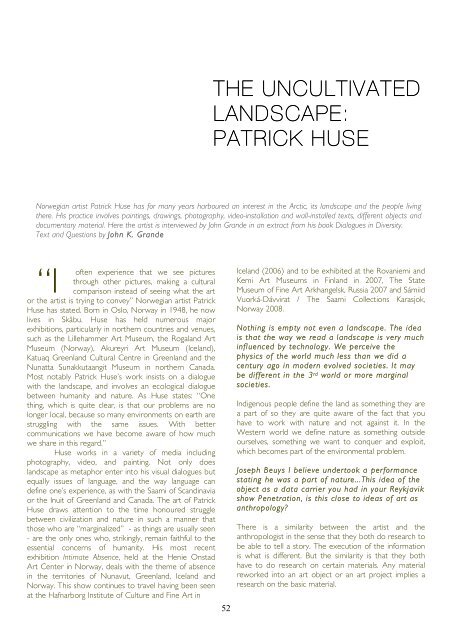M - Antennae The Journal of Nature in Visual Culture
M - Antennae The Journal of Nature in Visual Culture
M - Antennae The Journal of Nature in Visual Culture
You also want an ePaper? Increase the reach of your titles
YUMPU automatically turns print PDFs into web optimized ePapers that Google loves.
“I<br />
<strong>of</strong>ten experience that we see pictures<br />
through other pictures, mak<strong>in</strong>g a cultural<br />
comparison <strong>in</strong>stead <strong>of</strong> see<strong>in</strong>g what the art<br />
or the artist is try<strong>in</strong>g to convey” Norwegian artist Patrick<br />
Huse has stated. Born <strong>in</strong> Oslo, Norway <strong>in</strong> 1948, he now<br />
lives <strong>in</strong> Skåbu. Huse has held numerous major<br />
exhibitions, particularly <strong>in</strong> northern countries and venues,<br />
such as the Lillehammer Art Museum, the Rogaland Art<br />
Museum (Norway), Akureyri Art Museum (Iceland),<br />
Katuaq Greenland Cultural Centre <strong>in</strong> Greenland and the<br />
Nunatta Sunakkutaangit Museum <strong>in</strong> northern Canada.<br />
Most notably Patrick Huse’s work <strong>in</strong>sists on a dialogue<br />
with the landscape, and <strong>in</strong>volves an ecological dialogue<br />
between humanity and nature. As Huse states: “One<br />
th<strong>in</strong>g, which is quite clear, is that our problems are no<br />
longer local, because so many environments on earth are<br />
struggl<strong>in</strong>g with the same issues. With better<br />
communications we have become aware <strong>of</strong> how much<br />
we share <strong>in</strong> this regard.”<br />
Huse works <strong>in</strong> a variety <strong>of</strong> media <strong>in</strong>clud<strong>in</strong>g<br />
photography, video, and pa<strong>in</strong>t<strong>in</strong>g. Not only does<br />
landscape as metaphor enter <strong>in</strong>to his visual dialogues but<br />
equally issues <strong>of</strong> language, and the way language can<br />
def<strong>in</strong>e one’s experience, as with the Saami <strong>of</strong> Scand<strong>in</strong>avia<br />
or the Inuit <strong>of</strong> Greenland and Canada. <strong>The</strong> art <strong>of</strong> Patrick<br />
Huse draws attention to the time honoured struggle<br />
between civilization and nature <strong>in</strong> such a manner that<br />
those who are “marg<strong>in</strong>alized” - as th<strong>in</strong>gs are usually seen<br />
- are the only ones who, strik<strong>in</strong>gly, rema<strong>in</strong> faithful to the<br />
essential concerns <strong>of</strong> humanity. His most recent<br />
exhibition Intimate Absence, held at the Henie Onstad<br />
Art Center <strong>in</strong> Norway, deals with the theme <strong>of</strong> absence<br />
<strong>in</strong> the territories <strong>of</strong> Nunavut, Greenland, Iceland and<br />
Norway. This show cont<strong>in</strong>ues to travel hav<strong>in</strong>g been seen<br />
at the Hafnarborg Institute <strong>of</strong> <strong>Culture</strong> and F<strong>in</strong>e Art <strong>in</strong><br />
THE UNCULTIVATED<br />
LANDSCAPE:<br />
PATRICK HUSE<br />
Norwegian artist Patrick Huse has for many years harboured an <strong>in</strong>terest <strong>in</strong> the Arctic, its landscape and the people liv<strong>in</strong>g<br />
there. His practice <strong>in</strong>volves pa<strong>in</strong>t<strong>in</strong>gs, draw<strong>in</strong>gs, photography, video-<strong>in</strong>stallation and wall-<strong>in</strong>stalled texts, different objects and<br />
documentary material. Here the artist is <strong>in</strong>terviewed by John Grande <strong>in</strong> an extract from his book Dialogues <strong>in</strong> Diversity.<br />
Text and Questions by John K. Grande<br />
52<br />
Iceland (2006) and to be exhibited at the Rovaniemi and<br />
Kemi Art Museums <strong>in</strong> F<strong>in</strong>land <strong>in</strong> 2007, <strong>The</strong> State<br />
Museum <strong>of</strong> F<strong>in</strong>e Art Arkhangelsk, Russia 2007 and Sámiid<br />
Vuorká-Dávvirat / <strong>The</strong> Saami Collections Karasjok,<br />
Norway 2008.<br />
Noth<strong>in</strong>g is empty not even a landscape. <strong>The</strong> idea<br />
is that the way we read a landscape is very much<br />
<strong>in</strong>fluenced by technology. We perceive the<br />
physics <strong>of</strong> the world much less than we did a<br />
century ago <strong>in</strong> modern evolved societies. It may<br />
be different <strong>in</strong> the 3 rd world or more marg<strong>in</strong>al<br />
societies.<br />
Indigenous people def<strong>in</strong>e the land as someth<strong>in</strong>g they are<br />
a part <strong>of</strong> so they are quite aware <strong>of</strong> the fact that you<br />
have to work with nature and not aga<strong>in</strong>st it. In the<br />
Western world we def<strong>in</strong>e nature as someth<strong>in</strong>g outside<br />
ourselves, someth<strong>in</strong>g we want to conquer and exploit,<br />
which becomes part <strong>of</strong> the environmental problem.<br />
Joseph Beuys I believe undertook a performance<br />
stat<strong>in</strong>g he was a part <strong>of</strong> nature...This idea <strong>of</strong> the<br />
object as a data carrier you had <strong>in</strong> your Reykjavik<br />
show Penetration, is this close to ideas <strong>of</strong> art as<br />
anthropology?<br />
<strong>The</strong>re is a similarity between the artist and the<br />
anthropologist <strong>in</strong> the sense that they both do research to<br />
be able to tell a story. <strong>The</strong> execution <strong>of</strong> the <strong>in</strong>formation<br />
is what is different. But the similarity is that they both<br />
have to do research on certa<strong>in</strong> materials. Any material<br />
reworked <strong>in</strong>to an art object or an art project implies a<br />
research on the basic material.












